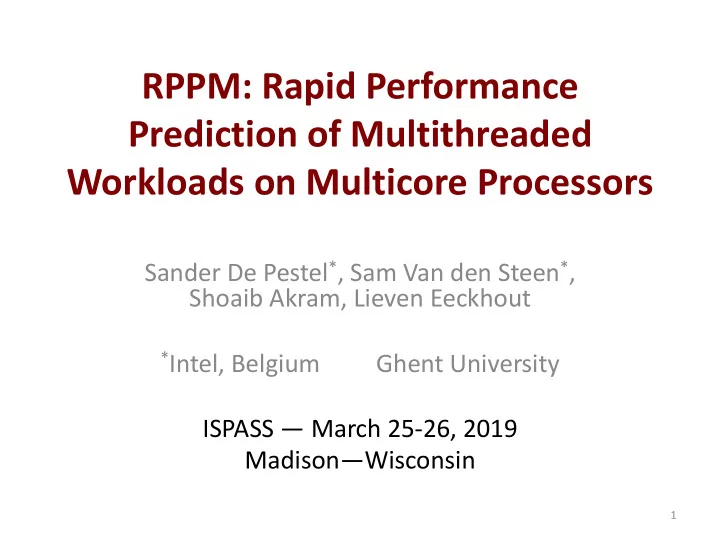

RPPM: Rapid Performance Prediction of Multithreaded Workloads on Multicore Processors Sander De Pestel * , Sam Van den Steen * , Shoaib Akram, Lieven Eeckhout * Intel, Belgium Ghent University ISPASS — March 25-26, 2019 Madison—Wisconsin 1
Analytical Modeling Key features – Super fast – Useful complement to simulation – Quickly explore large design spaces in early design stages Three types: – Empirical modeling • Black-box model, Easy to build, Needs training examples – Mechanistic modeling à this paper • White-box model, Insight – Hybrid modeling • Parameter fitting of semi-mechanistic model, Needs training 2
Prior Work in Mechanistic Modeling effective dispatch rate branch misprediction I-cache miss long-latency load miss time interval 1 interval 2 interval 3 Interval analysis for OOO cores Michaud [PACT’99], Karkhanis [ISCA’04], Eyerman [TOCS’09] Microarchitecture-independent model Van den Steen [ISPASS’15] Limited to single-core processors 3
Prior Work in Multicore Models Amdahl’s Law: high abstraction – Hill/Marty [Computer’08] Hybrid models: – Popov [IPDPS’15]: Amdahl’s Law + simulation Multi-programmed workloads: no inter-thread communication nor synchronization – Jongerius [TC’18] Machine learning: empirical, black-box model – Ipek [ASPLOS’06], Lee [MICRO’08] This work: multicore, multithreaded, mechanistic (white- box), microarchitecture-independent profile 4
Paper Contribution Microarchitecture-independent mechanistic performance model for multithreaded workloads on multicore processors one-time cost super fast: ~sec/min per-thread characteristics performance RPPM inter-thread interactions current limitation: same number of threads uarch-indep profile in profiling vs. prediction multicore config of multi-threaded app 5
Single-Threaded Interval Model uarch-indep branch predictor model [De Pestel, ISPASS’15] total cycle count miss rates predicted using StatStack [Eklov and Hagersten, ISPASS’10] uarch-indep MLP model [Van den Steen, CAL’18] N = dynamic instruction count D eff = effective dispatch rate; is function of ILP, I-mix, ALU contention [Van den Steen et al., ISPASS’15] 6
Naïve Extensions Apply single-threaded model [Van den Steen, ISPASS’15] to – Main thread avg 45% error main – Critical thread thread worker threads Fails to model – Synchronization barrier – Coherence effects – Resource contention critical thread: avg 28% error 7
Modeling Multithreaded Performance is Fundamentally Difficult Need super accurate per-thread performance prediction – Accumulating errors because of synchronization Need to accurately model – Inter-thread synchronization • Barriers, critical sections, producer/consumer, etc. – Inter-thread communication • Cache coherence – Inter-thread interference • Shared resources (e.g., LLC) 8
Accumulating Random Errors Predicting single-thread performance Random errors across short intervals cancel out Systematic errors (obviously) don’t 9
Accumulating Errors (cont’d) Predicting multithreaded performance b/w barriers Random errors do not cancel out 10
Problem Exacerbates with Thread Count Synthetic barrier-synchronized loop w/ 1M iterations and fixed work per iteration random error per prediction error synchronization epoch number of threads 11
RPPM Model Profiling Prediction Per-thread characteristics Predict per-thread Van den Steen [ISPASS’15] performance per synchronization epoch Synchronization Predict impact of synchronization Shared memory accesses Pin-based; measured per synchronization epoch 12
Profiling Synchronization Intercept library function calls in Pin – pthread and OpenMP – Automatic For example – Critical sections (pthread) pthread_mutex_lock pthread_mutex_unlock – Barriers (OpenMP) gomp_team_barrier_wait (gomp_barrier_t) User-level synchronization: annotate manually 13
Condition Variables Barrier using condition variables: insert marker function is not always called Similar solution for producer-consumer, semaphores, etc. Too cumbersome? No! – 4 Parsec benchmarks: pthread_cond_wait – facesim: pthread_cond_wait and pthread_cond_broadcast 14
Shared Memory Behavior Cold misses: first reference Conflict/capacity misses: StatStack [Eklov ISPASS’10] ABCDAABDDCAABEFCAB Reuse distance = no. references = 5 Stack distance = no. unique references = 3 Cache miss rate prediction for LRU cache 15
Shared Memory Behavior cont’d larger reuse distance à possibly negative interference per-thread reuse distance used for modeling private L1/L2 caches global reuse distance used for modeling shared LLC if a write à write invalidation shorter reuse distance à for D (infinite reuse distance) positive interference 16
Prediction Per-epoch active execution time Single-threaded model • To predict active execution time per synchronization epoch • Miss rates account for interference and coherence 17
Prediction Synchronization overhead Symbolic execution: fastest to slowest thread – Fastest thread(s) experience(s) idle time – Slowest thread determines execution time Critical sections, barriers, condition variables, thread create/join, etc. 18
Experimental Evaluation Rodinia (OpenMP) – Barrier synchronization Parsec (pthread) Simulator: HW-validated x86 Sniper , quad-core 4-wide OOO [Carlson TACO’14] 19
MAIN (models main thread): reasonable accuracy for Rodinia but highly inaccurate for Parsec Rodinia Parsec Summary 45%
CRIT (models critical thread): more accurate for Parsec Rodinia Parsec Summary 28%
RPPM (models critical thread per sync-epoch): 11% avg error versus MAIN (45%) and CRIT (28%) Rodinia Parsec Summary 11%
Design Space Exploration Which is the best performing 10-GOPS processor? smallest small base big biggest frequency (GHz) 5.0 3.33 2.5 2.0 1.66 width 2 3 4 5 6 Hybrid exploration strategy: – Use RPPM to predict optimum design – Simulate designs within 5% of predicted optimum Identify true optimum for all but one benchmark – RPPM predicts optimum for vast majority of benchmarks – Handful benchmarks need two simulation runs – pathfinder : within 2% of true optimum 23
Bottlegraphs: Visualizing a thread’s criticality and parallelism a thread’s criticality: share in total execution time simulation RPPM a thread’s parallelism: no. parallel threads when active 24 [Du Bois, OOPSLA’13]
Bottlegraphs: Balanced workloads Main thread distributes and co-works with worker threads 25
Bottlegraphs: Imbalanced workloads facesim : main thread performs slightly more work freqmine : main thread is bottleneck (but does parallel work) 26
Bottlegraphs: Highly imbalanced workloads Main thread does not perform any parallel work 27
Conclusions Microarchitecture-independent mechanistic performance model for multithreaded workloads on multicore processors – Accumulating random errors – Inter-thread synchronization, communication, interference Evaluation against simulation: 11% avg error versus MAIN (45%) and CRIT (28%) Use cases – Design space exploration – Workload characterization Future work: predict across thread counts – Predict Y-thread performance from X-thread profile (Y>X) – Predict Y-thread performance on X-core system (Y>X) 28
RPPM: Rapid Performance Prediction of Multithreaded Workloads on Multicore Processors Sander De Pestel * , Sam Van den Steen * , Shoaib Akram, Lieven Eeckhout * Intel, Belgium Ghent University ISPASS — March 25-26, 2019 Madison—Wisconsin 29
Recommend
More recommend